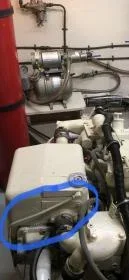Unlike a standard "open" radiator cap, A closed or recovery coolant system used a double sealed cap. easily identified by a second rubber gasket under the cap top, to seal the very top of the HE fill neck to the top of the cap. On a factory spec, these closed caps are rated around 7psi.
The overflow line, usually 1/4" clear water tubing/hose will pass from the H/E neck, just under the cap, to a remote bottle bottom fed. I install these bottles outboard of the engine and try to match the mid of the bottle level with the top of the cap.
This does not work every time and other locations are used that require some extra effort but any where close to this is preferred (IMO).
It is normal for a radiator or Heat exchanger to release some air or coolant as the engine warms up. This closed recovery method allows for any expansion air and coolant to expand and pass pass the cap. Now the recovery bottle catches any coolant lost.
As engine temperature and coolant pressure rinses, the cap closes.
Now the magic; When the engine is shut down and cools, coolant from the recovery bottle is drawn back in as the engine coolant contracts.
Eventuality, all the air is purged from the engines coolant system and you just maintain a level in the recovery bottle.
When all is working, never open that cap again.
There is an universal bottle that Cat & Cummins uses. About 2 gallons in vertical shape. I find them on e-bay.
So, after you run the engines, the bottle looks full. The next morning, it looks low. As long as that bottle never goes empty, all is good.


